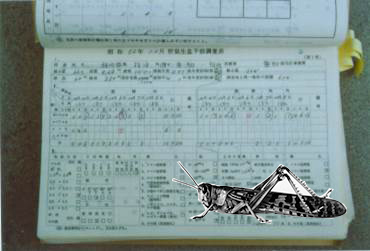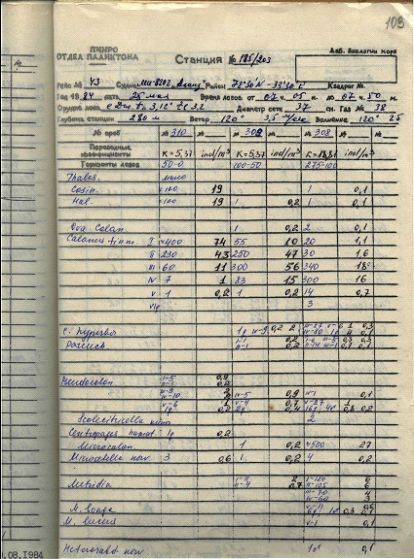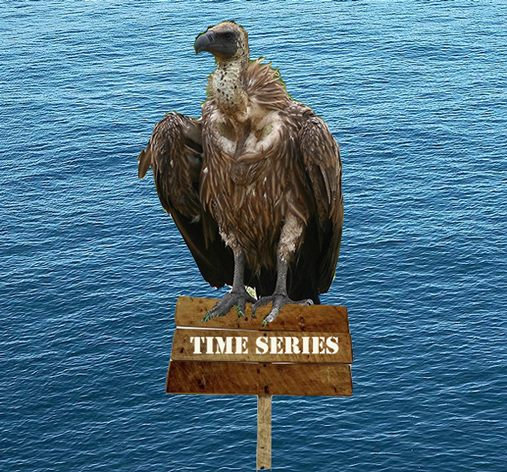The Marine Ecology Group at CEES
Our group (not only the marine one) is specialised in time series analysis, meaning that we are making statistical analyses of data collected over many years (several decades when we can find such data). Obviously for the youngest among us, such data can be older than they are (our oldest time series is >1000 years).
One of our main interests is the effect of climate variability, not to say change, on population dynamics. This type of exploration requires time series covering several decades. Collecting such long-term data requires considerable investment in time and human effort. Short from being able to collect long time series ourselves, we are relying on existing ones by collaborating with other researchers:
Once upon a time…

Figure 1. Both vole data and locust data were paper records.
In several parts of the world, naturalists or officials have been gathering information relevant for modern ecology and crucially actual in a period of drastic climate warming. For instance in Hokkaido Japan, data on grey-sided vole Myodes rufocanus (previously called Clethrionomys rufocanus) abundance were collected over 31 years with amazing dedication. These were stored in log books destined to recycling before being rescued at the last minute by Profs Stenseth and Saitoh, and led over the years to many important papers (e.g. Stenseth et al. 1996 and Saitoh et al. 1998). Among other these data helped to shade light on the influence of climate on biogeography and population cyclicity to name only two.
While characteristic, this story is not extreme in comparison with the next example. For more than 1000 years, Chinese officials have recorded the outbreaks of the oriental migratory locust Locusta migratoria manilensis, with the ultimate aim of predicting these outbreaks. In years with high abundance, the migratory locusts form devastating swarms that can move far from the original breeding area and cause crop failure and famine. In the 1950s, the Chinese naturalist Ma Shijun constructed using historical records an annual series of locust abundance back to year 957 AD. By linking this series with climate reconstructions, Stige et al. showed in a paper from 2007 that decadal mean locust abundance is highest during cold and wet periods. These periods coincide with above-average frequencies of both floods and droughts in the lower Yangtze River, phenomena that are associated with locust outbreaks. The 2007-paper marked the start of a fruitful Norwegian-Chinese collaboration, where we re-examined the historical records. Specifically, annual locust abundance data back to year 2 AD were extracted from >8000 historical Chinese documents and compiled in one time series by Tian et al. 2011. The analyses of this longer time series largely confirmed the conclusions from the shorter, “only” 1000-year-long, time series. This kind of work, while difficult can be extremely rewarding in term of new knowledge that can be achieved. Incidentally, the 1910-year-long time series of locust abundance is readily available from the web appendix of the paper, for anyone to dig into.
Fishing for data.

Figure 2. Example of a log book page from the Knipovich Polar Research Institute of Marine Fisheries and Oceanography
Getting marine data is generally more challenging than getting terrestrial data for the simple reason that the marine data are less accessible and often require huge investment to get (boat, crew…).
The end of USSR in the early 90s had two effects for marine research. The first was that the contact with Russian institutes became easier and the second that many long-term programmes of data collection were interrupted. With the end of USSR, priority of public funding in Russia changed, interrupting the data collection and letting the data in some cases unused in log books… This is what happened to the long-term Russian survey of fish eggs and larvae in the Barents Sea and Norwegian Sea between 1959 and 1993. In 2009, CEES in association with PINRO, IMR and Akvaplan-niva got funding from StatoilHydro to help digitise the data and revive them. The data are now digitized and joint Norwegian-Russian papers based on this unique information source are starting to come out (see blog of Kristina and of Leif).
This is not an isolated case. We know of several sources of marine data in paper format that are resting on forgotten shelves due to lack of funding to rescue them. In our own institute at the University of Oslo, data collected some from 1964 (covering oceanographic, plankton, fish and sea mammals) are still sleeping under pile of dust in the basement.
Data curation

Figure 3. Shelves with data archives in the basement of the Institute of biosciences, University of Oslo
In 2013, CEES became part of a new initiative, Norwegian Marine Data Centre (NMDC), with aim to render Norwegian data accessible. NMDC is led by the Institute of Marine Research (IMR) and assembles all the major marine oriented institutes in Norway (13 in total). The idea behind NMDC is to facilitate the professional processing and long-term storage of marine environmental and fisheries data and production of data products.
The purpose is to provide seamless access to marine data, and serve as the major national marine data infrastructure in Norway. The NMDC is thus an instrument tailored to boost the marine science efficiency in Norway through better marine data availability and also to provide access to data to the marine scientific community as a whole. For CEES it means that we had the opportunity to look into the basement archive and start the unsavoury job to list the data and to try to revive them. But this is a story for later.
“I can think of few things more important for ecological science and more appropriate for European collaborative funding, than the maintenance and curation of existing such time-series.”
Professor Lord May of Oxford, London, 4 February 2003
References
Stenseth, N.C., Bjornstad, O., & Saitoh, T. (1996). A Gradient from Stable to Cyclic Populations of Clethrionomys rufocanus in Hokkaido, Japan Proceedings of the Royal Society B: Biological Sciences, 263 (1374), 1117-1126 DOI: 10.1098/rspb.1996.0164
Saitoh, T., Stenseth, N.C., & Bjørnstad, O. (1998). The population dynamics of the vole Clethrionomys rufocanus in Hokkaido, Japan Researches on Population Ecology, 40 (1), 61-76 DOI: 10.1007/BF02765222
Stige, L., Chan, K., Zhang, Z., Frank, D., & Stenseth, N.C. (2007). Thousand-year-long Chinese time series reveals climatic forcing of decadal locust dynamics Proceedings of the National Academy of Sciences, 104 (41), 16188-16193 DOI: 10.1073/pnas.0706813104
Tian, H., Stige, L., Cazelles, B., Kausrud, K., Svarverud, R., Stenseth, N.C., & Zhang, Z. (2011). Reconstruction of a 1,910-y-long locust series reveals consistent associations with climate fluctuations in China Proceedings of the National Academy of Sciences, 108 (35), 14521-14526 DOI: 10.1073/pnas.1100189108

Log in to comment
Not UiO or Feide account?
Create a WebID account to comment